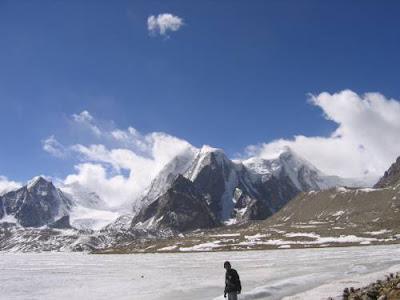TOURING SIKKIM
Best Season to Visit:
March to May as the temperatures are
amenable and mountains are lush with alpine flowers. October to December for
those loving the winter nip and the occasional snowfall.
Clothing : Summer light woollens,
Minter : Heavy woollens.
Entry Formalities :
All foreigners intending to visit Sikkim
can avail a 15 day permit. Permits for restricted areas i.e Gangtok, Rumtek,
Phodong, and Pemayangtse can be obtained from 24hrs in Advance from all Indian
Missions abroad, Sikkim tourism offices in Delhi, Calcutta, Siliguri,
Darjeeling and from the District Magistrate office, Government of West Bengal,
at Darjeeling and Gangtok after furnishing proper documents.
Permits: Domestic and Foreign tourists
visiting Tsomgo lake, Nathula and Yumthang require permits which are granted by
the superintendent of police ( check posts division) of the Sikkim police
Department, Gangtok.
First Day Tour :
1. Changu (Tsom-Go) Lake.This is a sacred lake as per belief of
the local people. Tsongo lake frozen over in Winter.

Nathula Pass. TsomGo lake situated at 12400 ft, is about a Km long and 50ft deep. This is 35 Km from Gangtok and the drive is of 2.5 hrs. Climb is pretty steep and there is need for woolens even in the summers, the winds can be pretty chilly. The lake is regarded extremely holy. Nathula Pass is situated at 14.400ft and is on the silk route; expect snow even in the summers. The wind is pretty chilly so carry heavy woollens. It is situated on the ancient trade route between China and India. The same has been reopened recently to boost trade with our northern neighbour. One can see Chinese soldiers on the other side of the border outpost. The Pass is heavily guarded and photography is restricted, one can get a view of heavy Artillery and military slogans written by arranging stones on the mountainside.
Baba Harbhajan Singh Temple:
Northern Sikkim
You will have to allocate at least 3
days best if you can add another day for leisure
· First day : Travel from
Gangtok to Lachen. Reaching Lachen in evening.
· Second
day : Early morning trip to Gurodongmar lake with a small stop for breakfast
at a village called Thangu. After Gurudongmar and a brief rest travel to
Lachung.
· Third
day: Travel from Lachung to Yungthang the valley of Rodohedrons.
Back towards Gangtok.
The north Sikkim trip has
both the attraction snow in winter and the Rhododendrons and alpine flowers in
summer.
Flip side :All the trips have to be
booked in advance due to the limited facilities at Lachen and Lachung and lack
of communication with the hotel owners at these places. The only media of
communication are the tour operators in Gangtok ( No telephone coverage in
these areas as yet). The government office in Gangtok for tourism
is also not very forthcoming with the actual conditions in
Lachen and Lachung, Every bodies bread and butter is linked to tourism
in Sikkim hence the truth about the climate and road conditions are a
closely guarded secret.
Lachen and Lachung are the two places at
which one stays during the visit. A minimum 3 day and 2 nights trip is
required, 4 days and 3 nights will make the trip more comfortable but you will
have to shell out around Rs 4000/ vehicle and 1500 per hotel room per day for
each day extension. ( The tourist agent will ask you to
be considerate with the Local hotel owner with regards to the food
made available due to the difficulty
in transporting materials to these locations). But the tourist
operators can become more professional by providing what they promise
as the same can be managed but the operators try to fleece small amounts in the
name of hardship of the locals. After the earthquake in Sikkim the
road conditions are very bad and there can be landslides that throws your
schedule out of gear. bargain with the tour operator as the substitute
offers if such an eventuality happens( usually they will not oblige once
money is in their pocket).
Lachung is situated at the height of
8600 ft and is described as the most picturesque village of Sikkim.

YumThang: Lachung
provides the basic amenities for an exploration of Yumthang valley. At Yumthang
situated at 11800 ft, the tree line ends but the rhododendron still blooms. It
has a hot spring rich in Sulphur. The route from Yumthang from Lachung is very
picturesque and is lined with rhododendron; the views are the best in May.
Yumthang is itself located on a flat valley near the tree line about 135 Km
from Gangtok in the Northern Sikkim.
Lachen is the sister village of Lachung and
is situated at the altitude of 9000 ft and at a 6 hr drive from Gangtok .
Lachen is situated on a grassy flat plain from which the pine clad mountains
rise. The village has 150 houses earlier inhabited only in winter.
Gurudongmar Lake is also worth a visit
in any season ( it will be covered with ice in winter and will look
deep blue in summer). the Tibetian landscape and views are stupendous, though
lack of oxygen at this altitude is a bother. Dont carry old and very small children to
Gurudongmar . It is believed to be a blessed lake . Situated at the altitude
of 17,100 ft, the lake freezes over in the winter except a one spot which the
locals believe have been specially blessed. The local Buddhists and the Sikhs
both have strong belief in the miraculous powers of the lake water.






